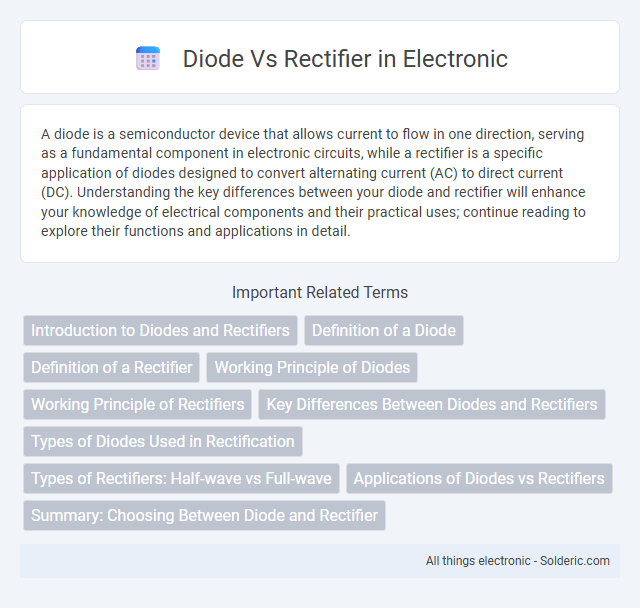A diode is a semiconductor device that allows current to flow in one direction, serving as a fundamental component in electronic circuits, while a rectifier is a specific application of diodes designed to convert alternating current (AC) to direct current (DC). Understanding the key differences between your diode and rectifier will enhance your knowledge of electrical components and their practical uses; continue reading to explore their functions and applications in detail.
Comparison Table
| Feature | Diode | Rectifier |
|---|---|---|
| Definition | Semiconductor device allowing current in one direction. | Device or circuit converting AC to DC using diodes. |
| Function | Controls current flow direction. | Converts alternating current (AC) to direct current (DC). |
| Types | PN junction diode, Zener diode, etc. | Half-wave rectifier, full-wave rectifier, bridge rectifier. |
| Application | Signal modulation, switching, voltage regulation. | Power supplies, battery charging, DC motor drives. |
| Component Role | Basic semiconductor unit. | Assembly of diodes in specific configurations. |
Introduction to Diodes and Rectifiers
Diodes are semiconductor devices that allow current to flow in one direction, serving as fundamental components in electronic circuits. Rectifiers are specialized diodes designed specifically for converting alternating current (AC) to direct current (DC), critical in power supply applications. Understanding the electrical characteristics and applications of diodes and rectifiers is essential for optimizing circuit design and efficiency.
Definition of a Diode
A diode is a semiconductor device that allows current to flow in one direction only, acting as a one-way valve for electrical signals. It is primarily used to control the direction of current flow in circuits, ensuring that current passes when forward biased and blocks it when reverse biased. Understanding a diode's role is essential for distinguishing it from a rectifier, which uses diodes to convert alternating current (AC) into direct current (DC).
Definition of a Rectifier
A rectifier is an electrical device that converts alternating current (AC) to direct current (DC), primarily using semiconductor diodes or other components to allow current flow in one direction only. Diodes serve as the fundamental building blocks in rectifiers, enabling the unidirectional conduction necessary for rectification processes such as half-wave, full-wave, and bridge rectification. The efficiency and performance of a rectifier depend on the type and configuration of the diodes employed within the circuit.
Working Principle of Diodes
Diodes operate based on the principle of allowing current to flow in one direction while blocking it in the opposite direction, utilizing a p-n junction formed by combining p-type and n-type semiconductors. When forward-biased, the diode reduces the barrier potential, enabling charge carriers to cross the junction and conduct electricity; when reverse-biased, it prevents current flow by widening the depletion region. This unidirectional conductivity is essential for converting alternating current (AC) to direct current (DC), forming the basis for rectifier operation.
Working Principle of Rectifiers
Rectifiers function by converting alternating current (AC) into direct current (DC) through the use of diodes, which allow current to flow in only one direction. The working principle of a rectifier involves leveraging the diode's unidirectional conductivity to block the negative half-cycles of AC, resulting in a pulsating DC output. Common types include half-wave, full-wave, and bridge rectifiers, each differing in efficiency and waveform smoothness.
Key Differences Between Diodes and Rectifiers
Diodes are semiconductor devices designed to allow current to flow in one direction, primarily used for signal modulation and switching, while rectifiers are specialized diodes configured to convert alternating current (AC) to direct current (DC) in power supply circuits. The key differences include their application focus, where diodes handle small signal levels and rectifiers manage high current and voltage for power conversion. Rectifiers often utilize multiple diodes arranged in bridge or half-wave configurations to achieve efficient AC to DC conversion, unlike single diodes typically used in basic circuit functions.
Types of Diodes Used in Rectification
Schottky, silicon, and germanium diodes are commonly used in rectification due to their varying forward voltage drops and switching speeds. Silicon diodes are popular for general-purpose rectification in power supplies, while Schottky diodes excel in high-frequency applications because of their low forward voltage and fast recovery time. You can select the appropriate diode type depending on efficiency, voltage, and frequency requirements in your rectifier design.
Types of Rectifiers: Half-wave vs Full-wave
Half-wave rectifiers use a single diode to convert AC to pulsating DC by allowing current to pass during one half-cycle, resulting in lower efficiency and higher ripple. Full-wave rectifiers employ either two diodes in a center-tapped transformer configuration or four diodes in a bridge arrangement to utilize both half-cycles of AC, producing smoother DC output with reduced ripple. The full-wave design offers improved voltage regulation and efficiency compared to half-wave rectifiers, making it ideal for power supply applications.
Applications of Diodes vs Rectifiers
Diodes are widely used in signal modulation, voltage regulation, and over-voltage protection, providing essential functions in electronic circuits. Rectifiers, a type of diode specifically designed for converting alternating current (AC) to direct current (DC), are crucial in power supply units for electronic devices and battery charging systems. Understanding the applications of diodes versus rectifiers helps optimize Your circuit design for either signal control or efficient power conversion.
Summary: Choosing Between Diode and Rectifier
Diodes are semiconductor devices that allow current to flow in one direction and are fundamental components in electrical circuits, while rectifiers specifically convert alternating current (AC) to direct current (DC) using diodes or diode arrays. Selecting between a diode and a rectifier depends on the application: simple signal rectification or protection requires a single diode, whereas power conversion and full-wave rectification need specialized rectifier configurations like bridge rectifiers. Understanding the voltage, current, and frequency requirements ensures optimal device performance and efficient circuit design.
Diode vs Rectifier Infographic

 solderic.com
solderic.com